|
"The first virtue of a painting is that is to be a feast for the eyes." Eugène Delacroix © 2001 Nita Leland |
|
Canadian artist Douglas Purdon and I met a long time ago (in Internet years) when we were both members of the Artist's Forum on Compuserve. I had the good fortune to meet Doug in person at a NAMTA trade show in Toronto and to see his incredible oil paintings. His book, Color Secrets for Glowing Oil Paintings, describes his unique color-mixing method. |
|
Q. Doug, how did you get started as an artist? |
 | |||
| Q. How about formal art education? A. I took art courses in collegiate, but majored in business courses, as I didn't believe it possible to make a gainful living by painting. When I started working, I continued painting in the evenings and weekends. As I became more critical of my work and realized that I needed some formal training, I attended the Ontario College of Art in the evenings and weekends, graduating with an honours in Fine Arts in 1987. By the time I graduated I had started to exhibit and sell my work and had started teaching. At that point I decided to take early retirement and work full time at painting, a decision I have never regretted. |
|
Q. And your commercial experience?
|
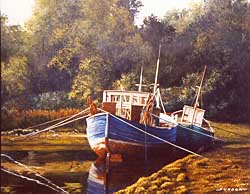 |
|
Q. What media have you worked with? A . I started painting with watercolour and then moved on to acrylics, which I used for several years as I didn't have a designated studio space and they were easier to work on for short periods. I had studied classical oil painting techniques at college but was frustrated by the length of time required for paintings to dry. What brought me back to oil was the introduction of alkyd mediums. Liquin allowed me to work in classical techniques without having to wait days until the paint dried. I also use alkyd fast-drying oil paint in conjunction with my traditional oils. I use water-mixable oils when either the fumes or safety issues of transporting traditional oils would be a problem. They are a good substitute, and once you get used to the slightly different working properties you can do anything that is possible with traditional oils. However, I use only traditional oils for my studio paintings, as there isn't the range of colours I require in water-mixable oils. |
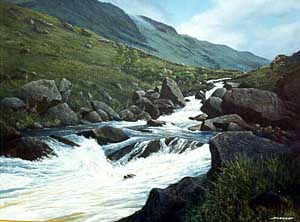 |
|
Q. You teach and do trade shows for Winsor & Newton. What
does this consist of? A. I am the Educational Advisor ( EDAD ) for Winsor and Newton in Ontario. In that capacity I visit colleges and universities. These presentations focus on the history of pigments and painting materials, their proper use and application, and related health and safety concerns. I'm based in Toronto but travel throughout the province of Ontario, which is larger than Texas. I have represented Winsor and Newton at trade shows as both the demonstration artist and the 'working artist' at their booth. I enjoy meeting other artists and people in the art materials field. A couple of years ago I attended the College Art Association show, where the majority of companies represented were publishers displaying all the new art books. By the time I left my credit cards were close to being maxed out! To say nothing of my overweight baggage!
Q. You've also had several exhibits in Scotland over the past few years.
Tell us about those. |
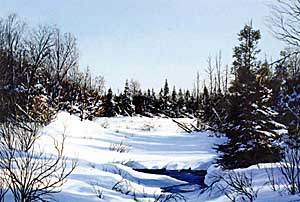 |
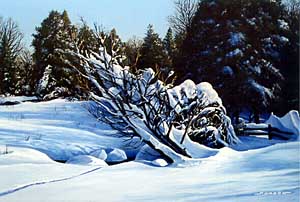 |
| Q. Your painting process in your book is very interesting and very clearly illustrated. A. As I mentioned previously, I studied both classical painting and illustration techniques and combine features of both in the book. Illustrators don't just jump into a painting without preparation but do preliminary composition, value and color roughs before starting. I find that this method allows me to manage and solve each problem before starting to paint. Alkyd mediums allow me to work in a classical technique and complete my paintings quickly. I developed a process I call "colour pooling," explained in detail in my book. Since the publication of the book I have conducted many workshops based on it, and I'm amazed how quickly students improve using these methods. As the creation process is broken into small manageable steps and each problem solved before starting on the painting, this method removes the fear of failure. By the time students start to work on their paintings they have solved most of their problems and can enjoy the painting process. | |
| Q. Any advice for beginning oil painters? A. Paint! Paint! Paint! and then Paint some more. The only way to learn to paint is by doing it. However, you should also read as many books on painting as you can, as you will learn something from each one. Visit galleries, not just the large public ones, but the private galleries as well. There you will see all types of painting and subject matter. Pay special attention to the methods of paint application, composition and use of colour. I make a point of visiting my local galleries as often as possible and at least once a year travelling to another city to see what is happening there. I still search out and read art books. I've just finished reading a book of landscape painting published in 1905 and have learned many new things, some of which I will incorporate in my own paintings and teaching. My work is constantly changing and, I hope, improving. One of the great pleasures of being an artist is that it is a never-ending voyage of exploration and discovery. You never get a chance to become bored, as you are constantly seeing familiar things in a new way. | |
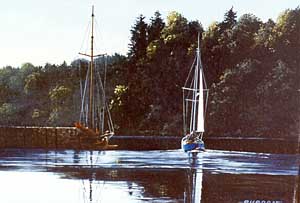 |
|
My thanks to Doug Purdon for sharing his work and viewpoint with us. eMail Doug for information about his oil- and alkyd-painting workshops in the United States and Canada. Doug's work is found on page 121 of my book, Exploring Color and page 110 of The New Creative Artist.
|
